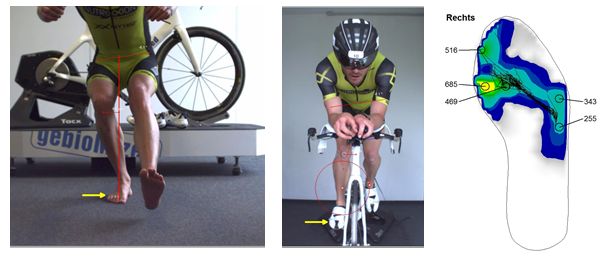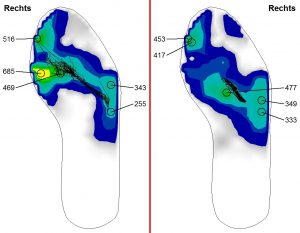The squat as an indicator in bike fitting
Squats are an exercise suitable for every purpose in bike fitting. This is why I will in the following deal with what the exercise of all exercises is all about.
There are typically two completely different reasons for doing a squat in bike fitting. On the one hand it is a movement diagnostic method carried out on solid ground before analysis is continued on the bike to determine physical compensation patterns. Hardly any bike fitter does without squats as the single-legged version is the movement that is most similar to cycling with regard to motion sequence. In the first part of this blog article I will talk about how to do a proper squat as test motion, the second part will be all about the squat as cycling-specific training measure – have fun reading!
Squats as diagnostic method on solid ground
Before a bike fitting analysis on the bicycle, the rider is asked to do a certain number of squat movements on one leg. This gives a first impression in which area the rider shows a tendency to insufficient movement control. The athlete’s whole body is observed while squatting and ideally is recorded from both sides and frontal view.
I prefer the “single leg to crossing balance” which is done with one leg being moved forwards for the first squat and backwards for the second. If the rider shows a lack of balance there is the opportunity to touch with one finger a wall.
This analysis method should not be lumped together with a correctly done squat – the bike fitter only gives the movement order and corrects as little as possible. This enables him/her to observe the whole range of compensational and evasive patterns.
Typical evasive patterns shown by the rider due to athletic reasons preventing him/her from fully controlling the movement can show as follows:
• Foot: do toes claw? Does the arch sag at front / side?
Tipp: Use a naviculometer to objectivy ridid / flexible longitudinal arch heights
• Ankle joint: excessive deviation under load in X or O ankle joint axis?
• Knee: excessive deviation under load in X or O leg axis?
• Pelvis: Evasion by moving the pelvis sidewards (so-called Trendelenburg’s sign) or by moving the upper body to the contralateral side (so-called Duchenne’s sign)?
Upper body: inclination forward?
Tipp: This is a common compensation pattern of weak lateral glute muscles – don´t miss to analyse the cyclist from the side view!
At this point, only indications are collected as to which contact point has to be observed particularly in functional analysis on the bike and which measurement technology should be used. I recommend using pressure analysis on the shoes’ insoles in case of strikingly instable arches. In case of a conspicuously instable pelvis the contact point analysis of the saddle should not be skipped, provided it has not already been planned anyway.
Results of a 2016 study furthermore indicate that female riders who showed insufficient movement control of the pelvis when doing squats confirmed this behavior on the bike – therefore those who evade significantly sidewards with the pelvis should be recommended to do some athletic training on solid ground in order to improve their cycle-specific torso stability.
Image 1: Correlation of test movement squat and on-bike movement control
A good examination measure in bike fitting is one that leads to a pragmatically relevant statement. In this case squats score in all aspects – two case examples from the laboratory for clarification:
The pelvis pattern
Exercise on solid ground: “Diagnostic squat”
Compensation pattern in movement analysis: evasion of pelvis to the side by x cm
Normal: stable arch and ankle joint axis
Confirmation on the bike
Compensation pattern in movement analysis: X leg axis in pedaling movement
Compensation pattern in contact point analysis: deviation of Center of Pressure pattern (COP saddle) in lateral direction (“rocking”)
Image 2: Valgic (X-) pattern in pushing period and lack of pelvic motion control
Bike fitting
In general a position is aimed for that matches the athletic condition of the female rider – moderately sporty and not too aggressive with regard to seat length and drop. Measures to be taken in order to optimize stability on the saddle are reduction of seat height, exchanging the model and optimize the position of the saddle.
In addition to this a manageable and effective athletic training is being developed together with the female rider. After 8 weeks she is asked to come by for a follow-up appointment during which the development of movement control on solid ground is checked via the deviation of the pelvis under load while squatting and on the bike via the deviation of the leg axis and the point of load application in the lateral axis.
The ankle joint pattern
Exercise on solid ground: “Diagnostic squat”
Compensation pattern in contact point analysis: buckling of ankle joint
No compensation pattern in pelvis region
Confirmation on the bike
Compensation pattern in contact point analysis: strong expansion of Center of pressure pattern (COP insole)
Image 3: Clawing toes and instable ankle axis in pushing period
Bike fitting
Results imply taking measures at the contact point foot / pedal as the usual suspects (stability of pelvis and torso) have not caught attention initially.
A tailor-made insole aiming at stabilizing foot and ankle joint will lead to a stabilization of the whole system as results in movement analysis and contact point analysis show.
An evaluation measurement of the construction should prove the aimed effect: a significantly reduced movement of the feet in the shoe.
Image 4: Stabilisation of the foot with a cycling specific insole construction
Conclusion
The test exercise in which the body weight is carried by one leg and the knee is bent must not be confused with the athletic squat exercise.
Being a potent indicator in the decision making process in bike fitting the competent analysis allows for a time-efficient and effective approach.
Source:
Kraus, 2016 “Female movement pattern in Cycling”, Science & Cycling Conference
gebioMized fitter with a partner contract (valid from November 2016) can purchase following documents:
• Conference Presentation “Female Specific Movement Pattern”
• Test description: One leg squat analysis in bikefitting (ISCO Level 1)
Please send a mail to lotte.kraus@gebiomized.de





